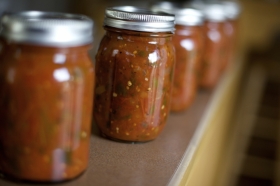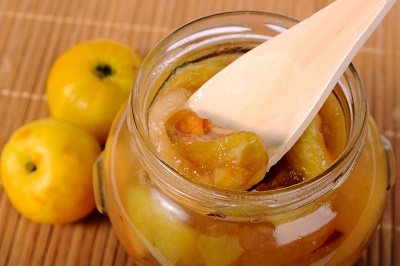
Growing up in rural Oregon, Beginning Canning Workshop instructor Debra Basquez was indoctrinated into canning culture from early on. “Many generations of my family used home canning as a way to preserve our harvest to make it through the winter,” she recalls. “My grandmother on my mom's side of the family was my biggest influence. We all lived on about 5 acres and her house was the hub for many family activities. The valley we lived in was full of many available fruits and vegetables. She raised a huge garden and sold produce. What wasn't canned for family use was sold to supplement her income. She had a large traditional cellar under her home where we stored our canned jars of food and other root cellar foods. She loved trying new recipes and taught me to can in the old, traditional way.”
With such expansive canning knowledge practically woven into her DNA, Basquez is, for all intents and purposes, a canning scholar in possession of information spanning everything from delicious canning recipes to evolving safety standards. “Having this knowledge and talking about it to people is what inspired me to start teaching classes,” she says. “I want to make sure people are getting safe and accurate home canning instructions. Doing the classes allows me to take some of the mystery or scary stereotypes out of home canning.”
Upon becoming certified as a Master Food Preserver through Washington State University (WSU), Basquez went on to teach canning courses at her local church and  eventually found herself heading Continuing Education classes at Pierce College in Puyallup. “Classes are kept small so that we can do both a lecture portion and hands on portion in our two hour time block,” she says. “This gets it very real for people.”
eventually found herself heading Continuing Education classes at Pierce College in Puyallup. “Classes are kept small so that we can do both a lecture portion and hands on portion in our two hour time block,” she says. “This gets it very real for people.”
When discussing her philosophy of canning, Basquez considers it both an art and a science. “An example of science is when making jams and jellies, you can't have a proper gel or ‘set’ if you don't follow recipe ratios of fruit, sugar and pectin,” she says. “You will still have an edible, safe product to consume, but not with the desired results. As for it being an art, this is a ‘lost’ art that many people are getting back into. We've lost our self-sustainability with the introduction of grocery and mega stores in recent years. (i.e. Costco, Sam's Club, Walmart). I consider home canning an art platform that is pleasing to the eye, or at least in my eye. I'm drawn to anything in Mason jar form. To me it beholds great beauty when I see jars of home canned product lining a shelf in a pantry or storage area. There are so many colors and textures represented in the jars. It also represents hard work and self-reliance.”
For those new to canning, Basquez suggests locating a good handbook like the Ball Canning Book, So Easy to Preserve or use the National Center for Home Food Preservation website all of which will help to take the first steps toward mastering canning.
Getting a solid overview on the canning process helps the neophyte prepare for the particulars. “Canning has two methods of processing,” she says. “One is known as waterbath canning for high acid foods such as jams, jellies, pickles and fruit. The other is pressure canning for low acid foods such as meats, vegetables and seafood. So depending on what you want to can, the method needs to be researched prior to attempting.”
Basquez says successful canning is about having the right equipment for the right job. “(T)he whole purpose of home canning is making a safe product for you and your family to consume. For waterbath canning (high acid foods), you simply need a large kettle (waterbath canner) or a large stock pot that you can put some type of rack in the bottom to get the jars off the bottom of the kettle and tall enough to cover the jars submerged in water. For low acid foods, they need to have a pressure canner (not a pressure cooker) to process these items safely. Pressure canners can be intimidating for some people, but if they read the instructions (or take one of my offered classes), they can safely process their product at home.”
According to Basquez, canning is not only a financially beneficial exercise, but self-sustaining one as well. “Canning is a great way to save money, if you grow your own food or have access to fruits and veggies by other means. It is a healthier option for people who want to control the sugar, salt and preservatives that go into their food,” she says. “Home canning can mean self-sustainability to certain people. If there were a natural disaster or economic collapse (either nationwide or losing a job in their household), having a pantry with food in it can help meet their physical needs. It's a fun way to use up food purchased at local farmer's markets or when you find a great deal on meats.”
Sadly, canning is not really a process open to a great deal of culinary experimentation and playing fast and loose with rules can actually foil one’s efforts. “Canning follows rigid rules because of pH (acid level) of food,” says Basquez. “When you deviate from a tested recipe, you risk putting the recipe into another canning method. An item that has a waterbath processing method could now be a pressure canning method. Unless you are a scientist and have access to testing recipes, it's best not to experiment. For example, salsa recipes are an item not to be changed or altered. Tomatoes are considered borderline on the pH scale and when you add onions and peppers, you just lowered the pH value, but because salsa recipes have added acid such as vinegar or lemon juice, it become a ‘high acid’ recipe and processing method. If you change the amount of each item or add an additional item such as fresh herbs, you've changed the pH and it could be unsafe. As a note, dried herbs do not alter pH levels, so those can be added freely and you can experiment with altering the flavor of a recipe. You need to be very careful.”
Contrary to popular belief, canning is not forever. In fact, Basquez, along with canning practitioners the world over, recommends using your home canned goods within a year. “(The) product is recommended to be used within one year not for safety, but for quality,” she says. “It's recommended you eat it within the one year time frame and then can new, so you always have very fresh product. That said, product can last for years if properly canned and the seal is intact. Over time, the product will lose color, turn dark, and look unappealing, but safe nonetheless. Food should be stored in a cool, dry place.”
If you have not gathered, canning is a huge passion for Basquez and she cannot wait to share what she knows with others. “I love talking about my passion, home canning,” she says. “I read everything I can get my hands on about home canning. I buy every book (good or not) and see what is out there. This helps me guide a class safely on the right path. It's a part of who I am, in my blood so to speak. I read things like the CDC reports on botulism cases associated with home canning (which is very rare) and how they happened, so I can educate on what went wrong, so someone else doesn't make the same mistake. My passion about canning is safety and I don't want to see our community and nation lose this art form.”
Learning to can is a very hands-on process that Basquez is confident her students will come to master. “I love showing them the beautiful product in the jars that I bring to class, letting them sample the good food that comes out of the jars and sending them home with a jar of product that they helped make in class. They have ownership of the product that they're bringing to their table. A sense of pride if you will. Then they take this knowledge and create for themselves food products that they're excited about.“
Learn more about Beginning Canning Workshop.
Photo credit #3: Karen and Brad Emerson_cc_2.0
Read the complete article at Beginning Canning Workshop